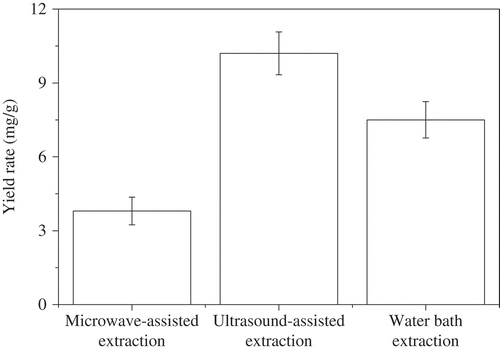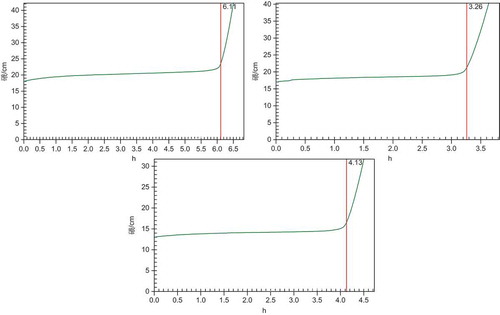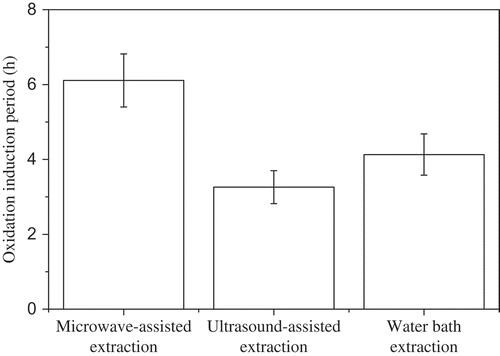Abstract
The effects of microwave-assisted extraction, ultrasound-assisted extraction and water bath extraction on the antioxidant activity of apple polyphenols are reported in this short communication. This study evaluated these methods based on their effect on the antioxidant activity of apple polyphenols whereas previous studies focused only on the yield rate of the extraction methods. The oxidation induction periods of apple polyphenols were 6.11, 3.26 and 1.13 h for microwave-assisted extraction, ultrasound-assisted extraction and water bath extraction, respectively. This result indicates that from the perspective of antioxidant activity protection microwave-assisted extraction is much better than the other two methods. Hopefully, this study could attract researchers’ attention to the property of apple polyphenols in extraction and promote the development of natural polyphenols extraction methods.
En esta comunicación corta se examinaron los efectos de la extracción asistida por microondas, la extracción asistida por ultrasonido y la extracción por baño de agua, en la actividad antioxidante de los polifenoles de la manzana. Este estudio evaluó estos métodos basándose en su efecto en la actividad antioxidante de los polifenoles de la manzana mientras que estudios previos se centraron únicamente en el índice de productividad de los métodos de extracción. Los periodos de inducción a la oxidación de los polifenoles de la manzana fueron 6,11, 3,26 y 1,13 h para la extracción asistida por microondas, la extracción asistida por ultrasonido y la extracción por baño de agua, respectivamente. Este resultado indicó que desde la perspectiva de protección de la actividad antioxidante, la extracción asistida por microondas es mejor método que los otros dos. Con suerte, este estudio podría atraer la atención de investigadores hacia las propiedades de los polifenoles de la manzana en la extracción y promover el desarrollo de métodos naturales de extracción de polifenoles.
Palabras clave:
1. Introduction
Apple and apple products are one of the major fruits and fruit products consumed all over the world (Konopacka et al., Citation2010; Virot, Tomao, Le Bourvellec, Renard, & Chemat, Citation2010). However, in the apple juice-processing industry, almost 25% of the apple becomes a by-product, called apple pomace, which consists of apple seed, skin, pulp and so on (He & Lu, Citation2014; Pingret, Fabiano-Tixier, Bourvellec, Renard, & Chemat, Citation2012). The disposal of apple pomace will not only lead to wastage of an important natural resource, but also cause serious environmental problems (Khan, Abert-Vian, Fabiano-Tixier, Dangles, & Chemat, Citation2010; Pirmohammadi, Rouzbehan, Rezayazdi, & Zahedifar, Citation2006). Therefore, scientific utilization of apple pomace has become a significant research topic in the food industry.
Polyphenols belong to a class of organic chemicals with high antioxidant activity, which can be used to prevent the deterioration of food and protect vitamins in food from oxidation (Suárez-Jacobo et al., Citation2011). Furthermore, polyphenols intake can prevent cancer and high blood pressure (Shoji & Miura, Citation2014). Therefore, the market demand for polyphenols in the food, drug and biotechnology industries is increasing rapidly. Apple pomace, which contains a high content of natural polyphenol, particularly condensed tannins, is a cheap by-product in the apple-processing industry (Pingret et al., Citation2012). In some countries, companies recycling or utilizing food waste could get financial supports from the government or an environmental protection association (Gibbs, Citation2013). It was reported that if low-cost apple pomace could be used for the production of polyphenols, the price of polyphenols could be reduced (Lu & Foo, Citation1997).
Several studies have focused on the improvement of polyphenols yield rate from apple pomace by optimizing the extraction parameters. Extraction time, temperature, liquid-to-solid ratio and the extraction-assisted method are important concerns in the improvement of polyphenols yield rate (Alonso-Salces et al., Citation2005; Hadiyanto, Sutanto, & Suharto, Citation2014). It was reported that the antioxidant activity of polyphenols is an important factor determining its use in the food industry (Candrawinata, Golding, Roach, & Stathopoulos, Citation2015). However, research concerning the effect of extraction methods on the antioxidant activity of apple polyphenols was limited. The objective of this short communication is therefore to analyse the effect of microwave-assisted extraction, ultrasound-assisted extraction and water bath extraction, on the antioxidant activity of apple polyphenols. Furthermore, these extraction methods were evaluated based on their effects on the antioxidant activity of apple polyphenols.
2. Methods
2.1. Materials and chemicals
“Fuji” apples were purchased from a local market (Henan, P.R. China) and processed by an electric extractor to produce apple pomace. Folin-Ciocalteu reagent was purchased from Fisher Scientific. Sodium carbonate was obtained from Kai Tong Chemical Co., Ltd (Tianjin, P.R. China).
2.2. Extraction methods
An orthogonal test was employed to optimize the extraction parameters, such as liquid-to-solid ratio, extraction time, temperature and so on. The experimental design for the orthogonal test is presented in . In orthogonal tests for three extraction methods, the condition that has the highest yield rate of polyphenols was regarded as the optimum extraction condition.
Table 1. Experimental design of orthogonal test.
Tabla 1. Diseño experimental del test ortogonal.
2.2.1. Ultrasound-assisted extraction
The optimum conditions are shown as follows: liquid-to-solid ratio was 10:1, extraction time was 25 min, temperature was 70°C and the power of the ultrasound instrument was 200 W. Apple pomace was extracted twice.
2.2.2. Microwave-assisted extraction
The optimum conditions are shown as follows: liquid-to-solid ratio was 5:1, extraction time was 25 s and the power of the microwave instrument was 1000 W. Apple pomace was extracted twice.
2.2.3. Water bath extraction
The power of the water bath instrument in this study was 600 W. The optimum conditions are shown as follows: liquid-to-solid ratio was 12:1, temperature was 60°C and extraction time was 4 h. Apple pomace was extracted once.
After extraction, the samples were centrifuged and the supernatants were used for the polyphenols content analysis.
2.3. Apple polyphenols content analysis
About 5 g of freeze-dried apple pomace was placed in a per flask and extracted using three methods. The total polyphenol content was measured according to the method described by Loncaric, Dugalic, Mihaljevic, Jakobek, and Pilizota (Citation2014). Around 0.2 mL apple polyphenols extract and 1.8 mL double-distilled water were added into the test tube. Then 10 mL Folin-Ciocalteu reagent (1:10) was added to the solution. Finally, 8 mL of 7.5% Na2CO3 solution was added into the test tubes. After 120 min, the absorbance at 765 nm by a spectrophotometer was read using a visible spectrophotometer (Loncaric et al., Citation2014).
2.4. Analysis of antioxidant activity
An oxidation stability tester (743 Rancimat, Metrohm) was used to analyse the antioxidant activity of apple polyphenols extracted by different methods. Analysis of the antioxidant activity was performed according to the method described by Nieto, Hodaifa, & Lozano Peña (Citation2010). In the operation of the tester, gas flow and temperature were set as 20 L/h and 110°C, respectively. Figures that could reflect the induction period (h) were provided by the oxidation stability tester. In this study, the oxidation induction period (h) was used to indicate the antioxidant activity of apple polyphenols.
2.5. Statistical analysis
In this study, all tests were performed in triplicate. The average result was shown as means ± standard deviation. Excel was used to analyse the result of the orthogonal test and SPSS was used to analyse the variance of the final result.
3. Results and discussion
3.1. Yield rates of apple polyphenols
Yield rates of different methods indicated that microwave-assisted extraction had the lowest yield rate (3.8 ± 0.6 mg/g of polyphenols in apple pomace) whereas the ultrasound-assisted extraction method had the highest rate (10.2 ± 0.9 mg/g of polyphenols in apple pomace) (). This result supports previously published studies stating that the ultrasound-assisted extraction method could obtain a high yield rate of polyphenols from natural resources (Vilkhu, Mawson, Simons, & Bates, Citation2008). Based on this result, some researchers stated that the ultrasound-assisted extraction method should be widely used in natural polyphenols production industry (Khan et al., Citation2010).
3.2. Oxidation induction periods
The oxidation induction periods of apple polyphenols extracted by the microwave-assisted method, ultrasound-assisted method and water bath method were 6.11, 3.26 and 4.13 h, respectively (). The comparison of this result indicated that the oxidation induction period of the microwave-assisted method was 87.42% higher than that of the ultrasound-assisted method and 47.94% higher than that of the water bath method (). Therefore, ultrasound-assisted extraction could seriously damage the antioxidant activity of apple polyphenols during extraction whereas the damage of microwave-assisted extraction to the antioxidant activity was limited. There are two possible reasons for this phenomenon. First, the cavitation effect of ultrasonic waves and the high temperature of the solution were responsible for the oxidation of apple polyphenols in ultrasound-assisted extraction. It was reported that ultrasound waves could damage the antioxidants and cause oxidation (Sies, Citation1997; Yu, Bai, Hu, & Wang, Citation2003). Second, the extraction period of ultrasound-assisted extraction (50 min) was much longer than that of microwave-assisted extraction (50 s). The long extraction time was also an important factor leading to the oxidation of apple polyphenols in ultrasound-assisted extraction. In water bath extraction, the high temperature (60°C) and long extraction period (4 h) should be responsible for the oxidation of apple polyphenols (Hadiyanto et al., Citation2014; Virot et al., Citation2010). Although reducing the temperature and extraction period could prevent the oxidation of apple polyphenols in the water bath extraction process, the yield rate would decrease as well (Bucić-Kojić, Planinić, Tomas, Bilić, & Velić, Citation2007). Therefore, from the perspective of antioxidant activity protection, microwave-assisted extraction is much better than the other two extraction methods.
3.3. Energy cost
In this study, polyphenols were extracted from apple pomace, of which the cost was very low. Therefore, the cost of energy consumption is an important concern in the apple polyphenols production industry. The electricity costs of microwave-assisted extraction, ultrasound-assisted extraction and water bath extraction were 0.73 kWh/g apple polyphenols, 3.27 kWh/g apple polyphenols and 64 kWh/g apple polyphenols, respectively. Therefore, from the perspective of energy cost, microwave-assisted extraction is better than the other two extraction methods.
4. Conclusions
This research showed that to protect the antioxidant activity of apple polyphenols microwave-assisted extraction should be used although the yield rate of polyphenols in microwave-assisted extraction was not higher than that of the other two extraction methods. Previous studies only used the yield rate to evaluate apple polyphenols extraction methods while ignoring the degradation of the antioxidant activity of polyphenols in the extraction process. This study aims to change this attitude and encourage researchers to focus on the property of apple polyphenols in the extraction process. Further research is necessary to understand the mechanism of the changes of the antioxidant activity of apple polyphenols in extraction and protect its antioxidant activity.
Disclosure statement
No potential conflict of interest was reported by the authors.
References
- Alonso-Salces, R. M., Barranco, A., Corta, E., Berrueta, L. A., Gallo, B., & Vicente, F. (2005). A validated solid–liquid extraction method for the HPLC determination of polyphenols in apple tissues: Comparison with pressurised liquid extraction. Talanta, 65(3), 654–662. doi:10.1016/j.talanta.2004.07.051
- Bucić-Kojić, A., Planinić, M., Tomas, S., Bilić, M., & Velić, D. (2007). Study of solid–liquid extraction kinetics of total polyphenols from grape seeds. Journal of Food Engineering, 81(1), 236–242. doi:10.1016/j.jfoodeng.2006.10.027
- Candrawinata, V. I., Golding, J. B., Roach, P. D., & Stathopoulos, C. E. (2015). Optimisation of the phenolic content and antioxidant activity of apple pomace aqueous extracts. CyTA-Journal of Food, 13(2), 293–299. doi:10.1080/19476337.2014.971344
- Gibbs, S. L. (2013). Population and environment: A review of funding themes and trends. Environment Change and Security Project Report (9), 41–58.
- Hadiyanto, H., Sutanto, A. A., & Suharto, Y. (2014). Ultrasound assisted extraction of antioxidant from Coleus tuberosus peels. Carpathian Journal of Food Science and Technology, 6(1), 58–65.
- He, Y., & Lu, Q. (2014). Impacts of water properties on the quality of steamed bread. Carpathian Journal of Food Science and Technology, 6(1), 25–31.
- Khan, M. K., Abert-Vian, M., Fabiano-Tixier, A.-S., Dangles, O., & Chemat, F. (2010). Ultrasound-assisted extraction of polyphenols (flavanone glycosides) from orange (Citrus sinensis L.) peel. Food Chemistry, 119(2), 851–858. doi:10.1016/j.foodchem.2009.08.046
- Konopacka, D., Jesionkowska, K., Kruczyńska, D., Stehr, R., Schoorl, F., Buehler, A., … Bonany, J. (2010). Apple and peach consumption habits across European countries. Appetite, 55(3), 478–483. doi:10.1016/j.appet.2010.08.011
- Loncaric, A., Dugalic, K., Mihaljevic, I., Jakobek, L., & Pilizota, V. (2014). Effects of sugar addition on total polyphenol content and antioxidant activity of frozen and freeze-dried apple purée. Journal of Agricultural and Food Chemistry, 62(7), 1674–1682. doi:10.1021/jf405003u
- Lu, Y., & Foo, L. Y. (1997). Identification and quantification of major polyphenols in apple pomace. Food Chemistry, 59(2), 187–194. doi:10.1016/S0308-8146(96)00287-7
- Nieto, L. M., Hodaifa, G., & Lozano Peña, J. L. (2010). Changes in phenolic compounds and Rancimat stability of olive oils from varieties of olives at different stages of ripeness. Journal of the Science of Food and Agriculture, 90(14), 2393–2398. doi:10.1002/jsfa.4097
- Pingret, D., Fabiano-Tixier, A.-S., Bourvellec, C. L., Renard, C. M. G. C., & Chemat, F. (2012). Lab and pilot-scale ultrasound-assisted water extraction of polyphenols from apple pomace. Journal of Food Engineering, 111(1), 73–81. doi:10.1016/j.jfoodeng.2012.01.026
- Pirmohammadi, R., Rouzbehan, Y., Rezayazdi, K., & Zahedifar, M. (2006). Chemical composition, digestibility and in situ degradability of dried and ensiled apple pomace and maize silage. Small Ruminant Research, 66(1–3), 150–155. doi:10.1016/j.smallrumres.2005.07.054
- Shoji, T., & Miura, T. (2014). Chapter 104 – Apple polyphenols in cancer prevention. In R. R. Watson, V. R. Preedy, & S. Zibadi (Eds.), Polyphenols in human health and disease (pp. 1373–1383). San Diego, CA: Academic Press.
- Sies, H. (1997). Oxidative stress: Oxidants and antioxidants. Experimental Physiology, 82(2), 291–295. doi:10.1113/expphysiol.1997.sp004024
- Suárez-Jacobo, Á., Rüfer, C. E., Gervilla, R., Guamis, B., Roig-Sagués, A. X., & Saldo, J. (2011). Influence of ultra-high pressure homogenisation on antioxidant capacity, polyphenol and vitamin content of clear apple juice. Food Chemistry, 127(2), 447–454. doi:10.1016/j.foodchem.2010.12.152
- Vilkhu, K., Mawson, R., Simons, L., & Bates, D. (2008). Applications and opportunities for ultrasound assisted extraction in the food industry — A review. Innovative Food Science & Emerging Technologies, 9(2), 161–169. doi:10.1016/j.ifset.2007.04.014
- Virot, M., Tomao, V., Le Bourvellec, C., Renard, C. M. C. G., & Chemat, F. (2010). Towards the industrial production of antioxidants from food processing by-products with ultrasound-assisted extraction. Ultrasonics Sonochemistry, 17(6), 1066–1074. doi:10.1016/j.ultsonch.2009.10.015
- Yu, T., Bai, J., Hu, K., & Wang, Z. (2003). The effect of free radical scavenger and antioxidant on the increase in intracellular adriamycin accumulation induced by ultrasound. Ultrasonics Sonochemistry, 10(1), 33–35. doi:10.1016/S1350-4177(02)00105-0



